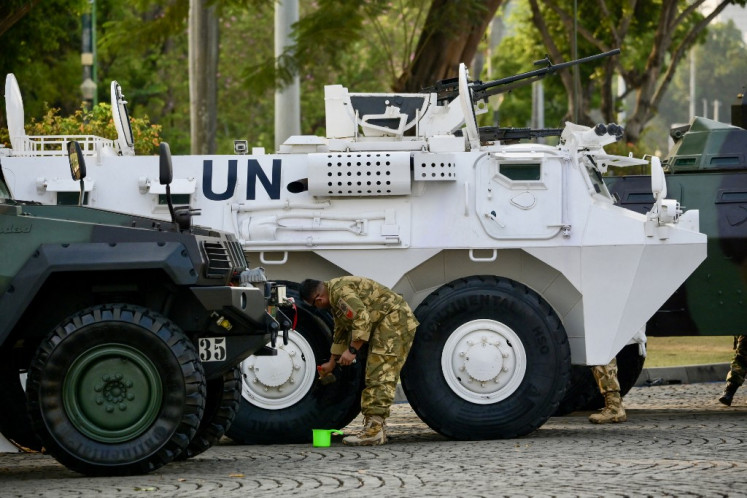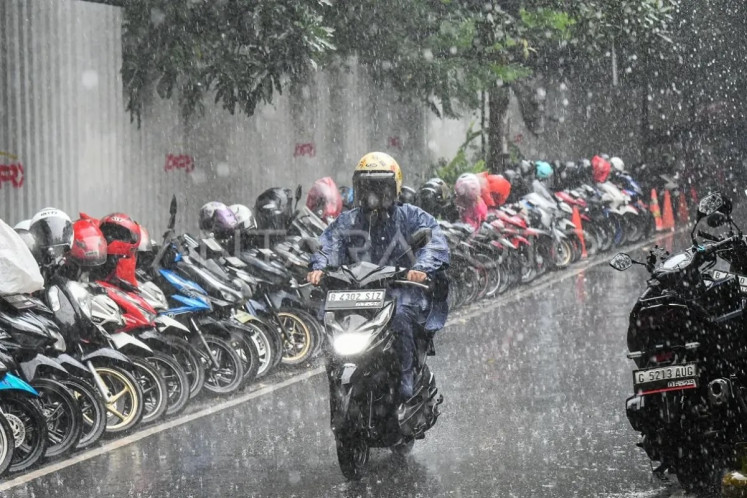Popular Reads
Top Results
Can't find what you're looking for?
View all search resultsPopular Reads
Top Results
Can't find what you're looking for?
View all search resultsTulamben underwater paradise
When divers see calm waters on a sunny day, it is as if they are being called forth to heaven to enjoy the marine paradise below
Change text size
Gift Premium Articles
to Anyone
When divers see calm waters on a sunny day, it is as if they are being called forth to heaven to enjoy the marine paradise below.
When we arrived at Tulamben, one of Bali's most frequented diving spots, the water was calm and there was a light breeze of refreshing wind.
Nature's beautiful welcome more than made up for our 2.5 hour drive from Sanur, where we had spent the night. Getting out of the car, there was a strong buzz of excitement among us.
Our diving guide from Bali Scuba, Chris, seemed to sense our mounting enthusiasm and tried to speed up preparations for our adventure. But he still needed to stick to the procedure. He explained the diving plan after the usual dos and don'ts briefing.
"We are going to dive at the following spots: the US Liberty Shipwreck, Coral Garden and the Drop Off," he said, pointing to the underwater map.
US Liberty shipwreck
While some people were still putting on their BCD (Buoyancy Control Device), Chris signaled to those who were ready to go with him. We walked some 100 meters along the sandy beach from the Paradise Resort, our base camp, to begin our adventure, diving to the entry point site.
Chris reminded us to walk carefully when we were approaching the edge of the beach, which was full of volcanic stones as big as adult's fist.
In a day at least 50 divers visit the diving site. They usually came in groups and the must-see spot was the shipwreck location.
"When holiday season comes the number (of divers) can double," Chris said.
The US Liberty shipwreck, which was torpedoed by the Japanese army during World War II, attracts divers to Tulamben. Those who prefer snorkeling can enjoy the ship stern for it is only located some 6 meters under the water surface with average visibility of 12 to 30 meters.
History has it the ship, which sunk in Lombok waters, was about to be towed to Singaraja port in North Bali but as Singaraja was already occupied by Japan army, the shipwreck was rerouted to Tulamben beach.
Mount Agung's powerful volcanic eruption in 1963 pulled the shipwreck deeper to the seabed - its present home -where it is heavily covered with anemone, gorgonian and coral.
When we reached the shipwreck, two schools of bright, silver trevally fish swam past us as if patrolling the site. They perfectly contrasted with the dark sand.
Hundreds of trevally moved in circles. They swam around the shipwreck and did not seem afraid of us. Locally known as kuwe, the trevally even approached some divers. Chris got an amazing welcome from surgeonfish that swarmed him as if performing their welcoming dance. Fishes in Tulamben are indeed friendly and recognize no fear - unlike in other less visited diving spots.
I remembered when I got a similar warm welcome from a school of small fishes in Bunaken, North Sulawesi. It was a priceless moment. The fishes not only "danced" around me but they also "kissed" my diving mask.
So when I saw what happened to Chris, I lifted my underwater camera and began pressing its shutter release to capture the precious moment and other beauties nearby.
If we observed carefully enough, we could spot ikan sebelah (flounders) and blue-spotted stingrays that hid beneath the sand, waiting for their lunch.

Not far from the shipwreck, I saw dozen of garden eels, eating floating planktons. Their bodies danced to the gentle sea currents that moved gently in this site. Many others rested with half of their bodies submerged in the seabed.
Our second destination was the Coral Garden, which was located right in front of the Paradise Resort. This garden is 2 to 15 meters depths, making it the perfect destination for snorkeling.
This spot has both soft and hard coral with light density. Yet, they were rich with marine life, including Napoleon fish, pipefish, parrotfish and clownfish. Even barracudas, which had sharp teeth, were seen swimming nearby when we got there. Chris said divers could come across blacktip sharks if they were lucky.
Columns between the soft and hard corals were the perfect hideout for shrimps. Local divers called them cleaner shrimps. One type was red and white but there was also one with combinations of red, white and green.
Fellow diver Emily Douglas from US was intrigued to find out if the shrimps were natural vacuum cleaners. She extended her hands to the shrimps, which immediately swarmed her hands and performed their famous duties.
Because of its average depth and generous light, this spot was also known as a perfect site for night-diving and heaven for hunting objects for macro-photography.
Our last destination was the Drop Off, located on the right side of Coral Garden. We walked to go to the side and had to go through the rocky beach.
The Drop Off site was formed naturally by a volcanic eruption. Our adventure began on a sandy slope, which was the starting point of the standard dive at Tulamben. At the end of the slope we could see the Drop Off's topography in the form of vertical walls whose depth could reach tens of meters.
The wall was heavily decorated with sponges and black coral. The marine life at this site is not very different to the Shipwreck site. There were butterflyfish, angelfish, Moorish idols and many other small fish with striking colors. Coral fish like groupers and anthias can also be seen at this site. Lucky divers can spot bigger fishes like whitetip and hammerhead sharks.
In general, Tulamben waters have relatively good visibility ranging between 12 and 30 meters. Its subtle currents make this place suitable for divers of any level.
Visiting Tulamben is a must for divers whenever they are in Bali. A growing number of diving operators are proof of the growing popularity of this recreational sport. Dive operators usually offer transport and accommodation, as well as alternatives to diving and snorkeling.
Tulamben has been included among spots recommended by nearly all diving operators, and is one of the best places to begin your underwater adventures.











